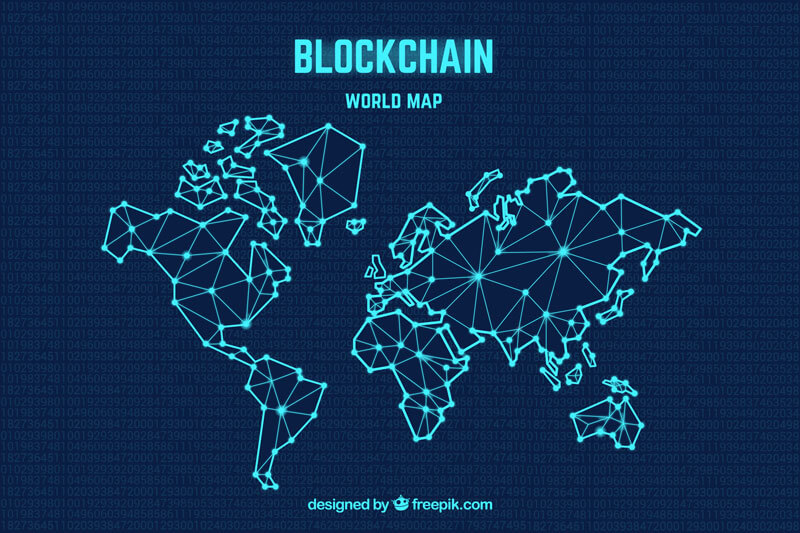As early as 1991, Stuart Haber and W. Scott Stornetta were the first to develop a technology that could inscribe information in small digital blocks using cryptography. In simple terms, cryptography refers to a method of storing and transmitting data in a particular form so that only those for whom it is intended can read and process it. Blockchain is a distributed ledger technology which helps to store information in a decentralized manner. When used to refer to a suite of technologies, Blockchain refers to a combination of the blockchain data structure, the blockchain algorithm as well as cryptographic and security technologies that combined can be used to achieve integrity in purely distributed peer-to-peer systems regardless of application goal. The key benefits of blockchain are greater transparency, enhanced security, improved traceability, increased efficiency and reduced costs. The data stored within a blockchain data structure is chronological, immutable and cannot be manipulated surreptitiously without the knowledge of others. This guarantees the authenticity, integrity and trustworthiness of all data stored within the blockchain network.
What does this immutable chain of blocks of data do? And most of all what is the use? To begin with, it creates Trust. With trust comes a lot of efficiency in managing two essential elements of business that is, time and money. When a business owner chooses to rely on an information with trust, he/she no longer requires an intermediary to vouch for the data, the source or the manner in which the data has been acquired or processed nor he/she is worried about the authenticity of the transaction either in part or full. In short, it removes middle men like analysts, lawyers, chartered accountants, accreditation agencies, securitization agencies and other researchers to vouch for the data thereby reducing lesser footprint and time. Hence, not only the data in those blocks are protected but the duration, date and chronological aspects of the data can be cross-checked and cross-referenced as well.
This technology has come at a time and has become popular across sectors where there is excessive use of Internet of Things (IoT) and Artificial Intelligence (AI), The “Internet of Finance,” the “Internet of Trust,” and the “Internet of Value.” It is a wide-ranging innovation, so there is no end to the types of applications that it is being extrapolated to. This technology has given birth to handling and transacting digital currencies and has famously been coined as cryptocurrencies.
Bitcoins are the earliest adaptation of this blockchain technology and has been the pioneer of cryptocurrency by enabling a peer-to-peer electronic cash system. When launched in 2009 by an anonymous programmer (or a group) Satoshi Nakamoto, it was deemed a watershed moment for the freedom of money. This article is not about Bitcoins but the technology behind it, just like the Internet is the technology behind emails. Let’s bear in mind this technology does not erase history but can alter it by adding to it, thus introducing distributed verifiability, auditability, consensus, authenticity and transparency with a time stamp – thereby promoting which is arterial to any business lifeline – TRUST. This magic word trust is created from usage of applied mathematics.
We are in the early days of adoption of this Distributed Ledger Technology (DLT) and when more and more sectors derive benefit from this, new laws will emerge along with innovations and disruptions in existing business practices. Industries and countries will be in the forefront of adoption and the legal sector in itself will play a major role in annihilating challenges from this new technology but will eventually use it to reform its own business rendering.
Take home
Most people have heard of Bitcoin, the decentralized, trustless payment system. But Bitcoin is just one application of blockchain. While the value of fiat currencies is determined centrally by issuing governments, the value of cryptocurrencies is determined in a decentralized manner by market dynamics in real time. The effectiveness of Bitcoin was to distribute the ledger containing all Bitcoin transactions among each user (or ‘nodes’) in the network.
Full article
Blockchain surge: An Indian perspective

Distributed Ledger Technology (‘DLT’)
In simple terms, visualize a transaction in a ledger – there are entries with dates and they are organized chronologically. If an entry has to be negated or altered another entry is passed. Blockchains act as a shared database, distributed across vast peer-to-peer networks that have no single point of failure and no single source of truth. No individual entity can own a blockchain network, and no single entity can modify the data stored on it unilaterally without consensus of peers. Similarly imagine there are two parties to a transaction, if an entry is made with one party the same entry is also reflected in the form of another entry in another party’s books. At every stage from initiation to sending a message to receiving a message there is a digital signature attached to it which is verified by all the Parties. Parties here are Miners to the transaction, the digital signature ensures secrecy and authenticity to the transaction while the entries are blocks that are stored at the Node Level and the whole ledger is based on a Distributed Ledger Technology. Miners are those trusted Parties who create blocks through the nodes while mining denotes such activity of creating blocks of data.
All Blocks are interlinked through a chain, a chain that cannot be delinked, altered or modified because it is immutable. If a historical block has a change in value or it needs to be modified or altered at a later date, a new block is set to the link at a later date to nullify an old block’s data. The old block remains to be seen by every node. This timestamp creation along with the read/write rules make this technology a robust, secure and a progressive system.
Ledgers are an age-old concept and these ledgers have by far proven to be a reliable reconciliation system for accountants for many decades. Generations have passed and the ledgers have been maintained. The same system is adopted with added decentralization techniques in this design language of DLT.
In a peer to peer platform, where there are many nodes which are responsible for creating blocks of data in this network, DLT ensures that data which is consistent, replicated, shared, and synchronized across multiple sites, countries, and organizations. If the data is redundant a mechanism is adopted by adding another layer to showcase the relevant data thus making this DLT unique by all standards. The ability to update independently and ensuring that an identical copy is replaced at any given point in time at all node levels makes this DLT more aspiring for other nodes to work on the same data in parallel.
For DLT to work effectively - there should be a need. A need that outweighs implementation costs. The need can be virtual and the underlying date is a digital asset that can be easily transferable. With cloud-based technologies on the rise and on-premise servers on the decline – this DLT puts the best foot forward. Blockchain can be used effectively for the maintenance of voluminous records as well as managing a large number of participants in a transaction.
Most people have heard of Bitcoin, the decentralized, trustless payment system. But Bitcoin is just one application of blockchain. While the value of fiat currencies is determined centrally by issuing governments, the value of cryptocurrencies is determined in a decentralized manner by market dynamics in real time. The effectiveness of Bitcoin was to distribute the ledger containing all Bitcoin transactions among each user (or ‘nodes’) in the network. Hence, every single transaction is authenticated by every single user by consensus (vide ‘proof of work’), and there is no centralized authority required for this. This technological advancement allows for removal of the centralized intermediary, without compromising on transactional financial security. Unlike traditional bank accounts that can be seized by the Government, the cryptocurrency in your wallet can never be taken away by anyone without your private Key. This is why the blockchain is often termed a ‘distributed ledger’ and is a subset of distributed ledger technology.
With more and more countries in the race to perfect this technology across multiple sectors, India with its huge marketplace in the form of private and public entities have been eyeing this as a revolution of many sorts creating disruptions and bringing innovations along with it. The participation by enterprises, technology providers, regulators, and governments is key to the development of the Blockchain and they in tandem increase adoption of Blockchain. Though the security aspect is covered to a large extent, the privacy parameters have to be clearly set at each node level and any discrepancy will pose a threat to such collaboration. The technology requires time to adopt, adapt, evolve and be perfected. Blockchain should be used so long it simplifies and adds values in a larger and longer duration than look for short-term benefits. There are many areas where Blockchain as a technology can potentially play a major role in India and they are:
a) Cryptocurrency
b) Identity Management – Passport, Ration Cards, Aadhaar (UID Management in India)
c) Land Registry and Records
d) Criminal History and Records
e) Education History and Records
f) Energy sector – hydro, wind, solar, nuclear and renewable resources integration
g) Medical History and Records
h) Legal History of Cases and Records and Smart Contracts
i) Ownership and transfer of intellectual property rights
j) Precedence and Case law management in a country or in a federal state
k) Supply Chain Management
l) Integration of Logistics and Warehousing Sector
m) Automobile and Spare-parts Industry
n) Share Markets, Mutual Funds, Chit Funds and Ticketing Sector
o) Gaming Industry and Lottery and Book-Keeping
p) Record keeping in Sports and Sports Rules and Sports Legal Management
q) Rollout of software updates, upgrades and version controls
r) Music Industry in Digital Rights Management
s) Live-stock Management
t) Financial Services Sector
u) Maintenance of Government records, forms, applications, orders and notifications
v) Any Database or Information Management
w) Transactions Management
x) Peer to Peer Energy Sharing Enterprises and Outage Management
y) Open Source Tech Platforms and IoT Management
z) Other uses and/or a combination of the above - Businesses across verticals should therefore be actively assessing how the blockchain can help streamline tasks for them and also see how a reduction in carbon footprint can really manifest in such usage
A major monetary source, Foreign Direct Investment (FDI) in India is a key driver of the country’s economic growth. India is a favourable investment destination for foreign investors given its relatively lower wages and special investment privileges in the form of tax exemptions etc. The country is today a part of the top 100 club on Ease of Doing Business (EoDB) and globally ranks 1st in the Greenfield FDI ranking. If Blockchain is to be deployed in as many as sectors described above, not only the FDI will rise but the GDP of India can see an exponential growth. Noticing this, Indian banks and Non-banking financing corporations have chosen to capitalize this Blockchain initiative as front runners of the technology. Indian banks that ran early blockchain pilots include ICICI Bank, Yes Bank, Kotak Mahindra Bank, and Axis Bank. In addition, Infosys, TCS, Wipro, and Cognizant were reported to have made significant investments and have deployed their tech support in expanding their capabilities in the technology already.
Blockchain technology could alleviate the pain points such as red-tapism, corruption, political discretions, poor sentiments, unpredictable tax and regulatory regime, unpredictable legal enforcements through regulations, retrospective amendments etc., by unleashing the largest youth population of the world and by tapping in to a huge domestic market being the world’s 7th largest economy by nominal GDP with the third largest Purchasing Power Parity. Blockchain will assist India in their endeavour to be an attractive destination for foreign investment.
If Blockchain were to provide a secured and thorough single window clearances and approvals, land and title diligences that are public and verified, company diligences and financial information duly verified with international standards, no hidden surprises from any new laws with retrospective additions, affirmation from state and central governments, systematic timelines for turn-key projects, and finally, a simple trust in India’s investment climate – Foreign Direct Investment will begin to flourish.
INDIA’s DILEMMA
India’s experience with cryptocurrencies has been just as uneven as that of China or the U.S., the real challenge for India has been law enforcement. Unlike China, India is an argumentative democracy, which means India can’t vindicate or exterminate violators, if necessary. Unlike the U.S., India has a very large population as well as arcane, conservative laws and an underfunded judiciary, which means lawsuits drag on in courts for years with no verdict or settlement.
Indeed, rule of law is a significant challenge in India, entirely unrelated to cryptocurrencies. When justice is likely to be delayed and therefore denied by default, it is understandable for regulators to seek to eliminate rather than manage risk to consumers. Bitcoin was the first to show how cryptocurrency could disrupt the current financial model, giving people the ability to make transactions without having a third party in the way. The increase in freedom, flexibility, and privacy continues to drive the inevitable march toward digital currencies as a new norm. Despite its benefits, Bitcoin’s (likely unintended) concentration of money and power present a meaningful barrier to mainstream adoption. That’s essentially why the Reserve Bank of India (RBI), India’s central bank chose to ban rather than regulate first. Slowly, the concept of Blockchain was perceived as per the finance minister’s speech where he maintained that Blockchain is very good for the economy while cryptocurrencies are not. This has only caused dissatisfaction and discontent to the cryptocurrency enthusiasts across the world, not knowing what India’s political stance is and its interpretation of the subject. The rampant ICO (Initial Coin Offering) boom and nonexistent coins forced the authorities to restrict banks and financial institutions from providing any services to individuals or businesses dealing in virtual currency.
The need to engage with the Reserve Bank of India (RBI), the Securities Exchange Bureau of India (SEBI) and the Central government to create a favorable and sustainable environment for cryptocurrency that accelerates innovation while also protecting consumers will only stem from provision of a stable legal environment and structured laws. On 6th of April 2018, the RBI published a notification, pertaining to virtual currency. In this notification, RBI strictly prohibited all the regulated entities to deal in or provide services for the facilitation of virtual currencies. The question on validity of cryptocurrency and the unsaid and implied bar over uncertified digital signatures, made it a misnomer for all potential users of such technology.
The government is patiently assessing Blockchain and The National Institution for Transforming India, also called (‘NITI Aayog’), is the Indian government’s premier policy think tank. Its current chairman is Prime Minister Narendra Modi. The institute published a draft discussion paper entitled “Blockchain: The India Strategy — Towards Enabling Ease of Business, Ease of Living and Ease of Governance.” The 59-page policy paper is part one of two. The paper focuses on formulation of statutory provisions clearly defining terms like Smart Contracts, virtual forms of currency and other legal aspects attached to it. As opposed to crypto-assets, most regulators’ statements on blockchain technology have been positive. The U.K., along with many countries including Australia, the U.S., Hong Kong, Malaysia, Singapore, Switzerland, Thailand, and United Arab Emirates have implemented or are exploring the idea of ‘regulatory sandboxes’ for this type of Blockchain technology as long as there is sufficient protection for its end users.
As per NITI Aayog – “Any transformative technology, in its initial stages of development, as it moves out of research/development phase to first few applications to large scale deployment, faces several challenges. Part of the problem is that such technologies are initially intended to solve a specific set of problems. Bitcoin, which has led to the popularity of decentralized trust systems and has powered the blockchain revolution, was intended to develop a peer-to-peer electronic cash system which could solve for double spending problem without being dependent on trusted intermediaries viz. banks. As Bitcoin started gaining prominence, the potential of underlying blockchain technology started gaining traction. However, some of the early design features that made Bitcoin popular, primarily limited supply and pseudonymity, have become potential challenges in wide scale implementation of Blockchain”. Bitcoin’s economic model is simple. There will only ever be 21 million Bitcoin in existence and this number is set in code. With only 21 Million to circulate among 7.5 Billion people around the world, there is not enough Bitcoin to go around. This scarcity is one of most important drivers of Bitcoin’s value. When there is scarcity there will be hoarding and this presents a problem for replacing the fiat currency and has been termed as “digital gold”.
Initial cost of implementation, complexity of the technology, lack of human resources and knowledge, high energy consumption and storage spaces for nodes, lack of sufficient infrastructure and bandwidth across the board, scalability issues, etc., have been the main impediments of blockchain becoming mainstream and thereby government delaying in their decisions on registering a robust regulatory framework now. NITI Aayog in their case studies suggest that India has been following this technology very closely and evaluating a strategy to find the best legal framework to suit the desired outcomes this technology can provide for India’s growth. Understanding and mapping the suitability of Blockchain to certain dynamic environments has been the primary task for this research. It has also been observed that this technology need not be very effective in promoting single transactions or certain type of transactions at large due to its implementation cost. India is still unsure at this stage on how to respond or react to a fraudulent activity committed through this technology. The legal system has to respond to the new technology by not treating this as a disruptive technology to existing business practices thereby building laws from the scratch to deal with identifying, penalizing miscreants and reacting to fraudulent data - without compromising other innocent users in the chain and thereby not committing the whole existing DLT to be fraudulent.
The legal challenges of pin-pointing accountability on pseudonymous network participants who might have indulged in nefarious activities or purchased something on “dark web” is complex although they are not entirely anonymous because of their IP addresses and network keys that can be traced. If there is a framework to fix accountability on any malicious user, privacy terms have to be revisited in such an environment then the question of absolute privacy which is another key element of Blockchain would have to be dispensed with. During litigation of a transaction, the legal framework should decide on how other transactions in the same blockchain can run without hindrance in parallel. This has people to believe that Immutability – the very essence of a secure service is also most vulnerable when a pernicious user corrupts the block(s) with fraudulent data. Finally, fixing a jurisdiction will be a problem where a cause of action is unknown and cannot be ascertained on a wide blockchain platform.
Then there is Decentralized Autonomous Organizations (DAO) which is a virtual autonomous organization, in which the functions of the organization exist in software, and the laws governing the organization’s functions are set into smart contracts that become automatically enforceable if a set of defined conditions are met. As a result, the DAO becomes a company that runs by itself, without a centralized governing body. When automatic machine language and learning takes control then the simple essences of contract law, such as offer, acceptance and consideration will be seen as severe grey areas for laws to cover and this is where Smart Contracts will have to be tested for legal sanctity in a level playing field inside a Blockchain domain.
Conclusion
India is in the nascent stages of adopting Blockchain technology. Laws could be made first to ensure regulatory sustenance at all levels and when India can pinpoint responsibility to each and every stakeholder, jointly or severally, only then the right environment will present for deployment of legal jurisprudence. It is also important to understand that the mechanism of decentralization or peer-to-peer exchange is a spectrum and not a binary concept. It also has to be understood separately from government regulation – networks completely regulated by governments can be decentralized and feature peer-to-peer exchange and, totally centralized systems can also be unregulated and operate beyond the bounds of law. Decentralized networks do not necessarily mean that they aren’t regulated so India has to forge ahead on what parameters they can decentralize using this technology and what form of regulations could be adopted to preserve its sanctity.
For instance, Andhra Pradesh is the first state in the country to introduce blockchain in land records and has also set up a Blockchain Centre of Excellence to have an in-depth research conducted son as to feature as India’s first Blockchain state. Other states like Maharashtra, Karnataka, Kerala, and Rajasthan are also following the lead. On the Cryptocurrency front, RBI had earlier imposed a ban on cryptocurrency trading in April 2018 that barred banks and other financial institutions from facilitating “any service in relation to virtual currencies''. In March 2020, India’s Supreme Court later overturned the central bank’s two-year-old ban on cryptocurrency trading in the country in a landmark judgment what many hailed as a “historic” verdict. A social network with just one member is of little use; a social network is worthwhile only when many of your own connections have signed on to it. Other users of the application must be brought on board to generate value for all participants and the same will be true for many blockchain applications. There is a long way to go, as we all by now know cryptocurrency is only a part of a booming Blockchain technology.
- Daniel Drescher, Blockchain Basics (Step 5): A suite of technologies.
- https://www.ibm.com/blogs/blockchain/2018/02/top-five-blockchain-benefits-transforming-your-industry/
- India placed 63rd out of 190 countries — an improvement of 14 places from its 77th position in year 2019. The country’s score improved from 67.3 last year to 71.0 this year, as per The Doing Business 2020 study, released by the World Bank.
- https://niti.gov.in/sites/default/files/2020-01/Blockchain_The_India_Strategy_Part_I.pdf
Comments
Related links
Main menu









.jpg)










